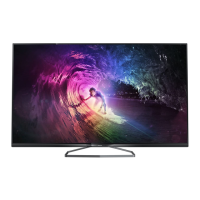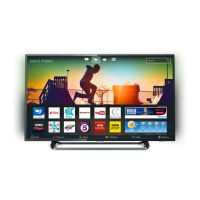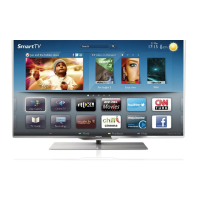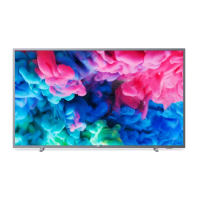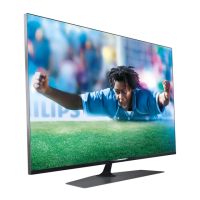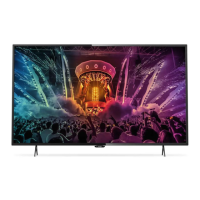Do you have a question about the Philips 47PFK6309 and is the answer not in the manual?
Connect to the internet for a new TV experience.
Browse and use various TV applications and websites.
Rent movies from your regional online video store.
Access and use social networks like Facebook and Twitter.
Make free video calls on your TV using Skype.
Use your smartphone or tablet as a TV remote or media controller.
Pause live TV broadcasts and record digital TV channels.
Optimize TV settings for gaming and play two-player games.
Operate connected devices with the TV remote using HDMI CEC.
Review important safety instructions before using the TV.
Instructions for installing the TV stand or mounting it on a wall.
Recommendations for optimal TV placement and viewing distance.
Guide on connecting and handling the TV's power cable.
Connect the TV wirelessly to the internet using a router.
Connect the TV to the internet using a network cable.
Configure network type, IP settings, and Wi-Fi Miracast.
General advice for connecting devices with HDMI, DVI, and other cables.
Operate connected devices via HDMI using the TV remote.
How to install and use a Conditional Access Module (CAM).
Connecting a set-top box (digital receiver) to the TV.
Connecting a satellite receiver to the TV.
Connecting and configuring a Home Theatre System.
Connecting a DVD player to the TV via HDMI or SCART.
Connecting a game console for optimal picture quality.
Connect a USB Hard Drive for pausing and recording TV.
Connect USB keyboard and mouse for easier navigation and text input.
How to switch the TV on, put it in standby, or switch it off.
Overview of the physical buttons on the TV.
Adjusting or switching off the TV's word mark lighting.
Detailed explanation of all buttons on the remote control.
Location and usage of the TV's infrared sensor.
Instructions for inserting and replacing remote control batteries.
How to clean the remote control safely.
How to watch channels, switch, and use channel lists.
Managing channel lists, favourites, and channel logos.
Instructions for renaming channels in the channel list.
How to lock channels to prevent unauthorized viewing.
Setting age ratings to control program access for children.
Accessing channel-specific options while watching TV.
Options for hearing and visually impaired users.
Adjusting picture format to fill the screen.
Opening and closing Text (Teletext) pages.
Configuring Text language and Text 2.5 settings.
Changing the language for TV menus and messages.
Selecting preferred audio languages for digital and analogue channels.
Switching subtitles on, off, or to automatic.
Using interactive TV features and HbbTV.
Switching HbbTV on/off and blocking HbbTV pages.
Setting up automatic updates for new TV channels.
Reinstalling channels via full or partial installation.
Resetting the TV to its original factory settings.
Copying the channel list to a USB device.
Uploading a channel list from a USB device to another TV.
Changing DVB settings for new channel installations.
How to watch satellite channels and change channels.
Managing satellite channel lists, filters, and options.
Creating and managing lists of favorite satellite channels.
Setting or changing the child lock code for parental controls.
Step-by-step guide to installing satellite channels.
Information on available satellite channel packages.
Setting preferred audio and subtitle languages.
Enabling special audio and subtitles for hearing impaired.
Activating audio commentary for visually impaired users.
Accessing the main menu to start TV activities.
Accessing on-screen and support topics.
Installing channels and adjusting TV settings.
Watching satellite channels.
Requirements for viewing TV guide information.
Navigating the TV guide, tuning to programs, and viewing details.
Recording or scheduling TV programs using a USB drive.
Finding and switching to connected devices.
Switching on connected devices from TV standby.
Operating connected devices with the TV remote.
Setting the TV to switch to standby automatically.
Setting or correcting the TV's clock time.
Deactivating the automatic TV switch-off feature.
Requirements for watching 3D content.
How to use and care for passive 3D glasses.
Guidelines for cleaning and maintaining 3D glasses.
Tips for the best 3D viewing experience.
Important health and safety warnings related to 3D viewing.
Connecting a game console and setting up the TV for gaming.
How to play two-player games, including 3D split-screen.
Viewing and playing media files from USB devices or computers.
Share your device screen wirelessly on the TV.
Pause live broadcasts and resume watching later.
Requirements for recording TV programs.
How to record and schedule TV programs.
How to play back recorded programs.
Making free video calls on your TV using Skype.
Requirements for making Skype calls on the TV.
Installing the camera and signing into Skype.
Navigating the Skype menu for profile, contacts, and settings.
Editing your personal Skype profile information.
Managing your Skype contacts and adding new ones.
How to accept incoming Skype contact requests.
Blocking or unblocking Skype contacts.
Making video or voice calls to Skype contacts.
Calling landline or mobile phones using Skype Credit.
How to answer or decline incoming Skype calls.
Setting up and managing Skype voicemails.
Configuring automatic sign-in and changing passwords.
Restricting video usage in Skype calls.
Setting preferences for incoming Skype calls.
Setting preferences for sending and receiving voicemails.
Signing out of your Skype account on the TV.
Closing the Skype application on the TV.
Links to Skype's terms of use and privacy policy.
Discover a new TV world by connecting to the internet.
Requirements for enjoying Smart TV Apps.
Configuring your Smart TV connection and settings.
Accessing internet sites and applications via Smart TV.
Watch TV channels alongside Smart TV apps or the internet.
Clearing internet memory and resetting Smart TV connection.
Watch TV programs from another TV in your home.
Requirements for streaming TV programs between TVs.
Steps for setting up and using Multi Room for the first time.
Accessing and using the TV's setup menu for various settings.
Updating channel lists or reinstalling all channels.
Configuring language, hearing impaired, audio description, and child lock.
Updating the TV's software via USB or Internet.
Selecting preset picture styles for easy adjustment.
Resetting a selected picture style to its original setting.
Adjusting picture settings like Colour, Contrast, and Sharpness.
Selecting preset sound styles for different audio experiences.
Adjusting the level of low tones in the sound.
Adjusting the level of high tones in the sound.
Setting the TV speaker sound effect.
Selecting Ambilight modes (preset or static colour).
Adjusting Ambilight brightness.
Setting up Philips Hue lamps to sync with Ambilight.
Adjusting Ambilight for wall colour influence.
Setting Ambilight fade-out effect when TV is switched off.
Creating a lounge light effect using Ambilight.
Syncing Hue bulbs with Ambilight's lounge light effect.
Options for hearing and visually impaired users.
Enabling special audio and subtitles for hearing impaired.
Activating audio commentary for visually impaired users.
Information on energy saving, disposal, and environmental impact.
Details on the TV's energy efficiency class and consumption.
Guidelines for product disposal and battery handling.
Technical details for aerial and DVB reception.
Technical details for satellite reception.
Information on screen size, resolution, and video formats.
Specifications related to the TV's power supply and consumption.
Physical dimensions and weight of the TV.
Details of all available TV input and output connections.
Supported media file formats and codecs.
Instructions for updating TV software via USB or Internet.
How to view the current TV software version.
Information on open source software used in the TV.
Acknowledgements and license texts for open source software.
Solutions for common TV issues with channels, power, and picture.
Troubleshooting picture problems like no image, distortion, or incorrect format.
Troubleshooting HDMI, EasyLink, USB, and audio issues.
Register your TV for benefits and support.
Accessing on-screen and online help resources.
Consulting online support for TV-related problems.
Contacting support for repair services and product information.
Understanding important safety instructions to prevent hazards.
Precautions to avoid electric shock and fire hazards.
Safety measures for handling and mounting the TV.
Preventing injuries to children related to TV placement.
Safety precautions during lightning storms.
Warnings about listening at high volumes.
Handling the TV in low temperatures.
Guidelines for cleaning and maintaining the TV screen.
Legal terms, warranty information, and product specifications.
Information on trademarks, logos, and software licenses.
Connect to the internet for a new TV experience.
Browse and use various TV applications and websites.
Rent movies from your regional online video store.
Access and use social networks like Facebook and Twitter.
Make free video calls on your TV using Skype.
Use your smartphone or tablet as a TV remote or media controller.
Pause live TV broadcasts and record digital TV channels.
Optimize TV settings for gaming and play two-player games.
Operate connected devices with the TV remote using HDMI CEC.
Review important safety instructions before using the TV.
Instructions for installing the TV stand or mounting it on a wall.
Recommendations for optimal TV placement and viewing distance.
Guide on connecting and handling the TV's power cable.
Connect the TV wirelessly to the internet using a router.
Connect the TV to the internet using a network cable.
Configure network type, IP settings, and Wi-Fi Miracast.
General advice for connecting devices with HDMI, DVI, and other cables.
Operate connected devices via HDMI using the TV remote.
How to install and use a Conditional Access Module (CAM).
Connecting a set-top box (digital receiver) to the TV.
Connecting a satellite receiver to the TV.
Connecting and configuring a Home Theatre System.
Connecting a DVD player to the TV via HDMI or SCART.
Connecting a game console for optimal picture quality.
Connect a USB Hard Drive for pausing and recording TV.
Connect USB keyboard and mouse for easier navigation and text input.
How to switch the TV on, put it in standby, or switch it off.
Overview of the physical buttons on the TV.
Adjusting or switching off the TV's word mark lighting.
Detailed explanation of all buttons on the remote control.
Location and usage of the TV's infrared sensor.
Instructions for inserting and replacing remote control batteries.
How to clean the remote control safely.
How to watch channels, switch, and use channel lists.
Managing channel lists, favourites, and channel logos.
Instructions for renaming channels in the channel list.
How to lock channels to prevent unauthorized viewing.
Setting age ratings to control program access for children.
Accessing channel-specific options while watching TV.
Options for hearing and visually impaired users.
Adjusting picture format to fill the screen.
Opening and closing Text (Teletext) pages.
Configuring Text language and Text 2.5 settings.
Changing the language for TV menus and messages.
Selecting preferred audio languages for digital and analogue channels.
Switching subtitles on, off, or to automatic.
Using interactive TV features and HbbTV.
Switching HbbTV on/off and blocking HbbTV pages.
Setting up automatic updates for new TV channels.
Reinstalling channels via full or partial installation.
Resetting the TV to its original factory settings.
Copying the channel list to a USB device.
Uploading a channel list from a USB device to another TV.
Changing DVB settings for new channel installations.
How to watch satellite channels and change channels.
Managing satellite channel lists, filters, and options.
Creating and managing lists of favorite satellite channels.
Setting or changing the child lock code for parental controls.
Step-by-step guide to installing satellite channels.
Information on available satellite channel packages.
Setting preferred audio and subtitle languages.
Enabling special audio and subtitles for hearing impaired.
Activating audio commentary for visually impaired users.
Accessing the main menu to start TV activities.
Accessing on-screen and support topics.
Installing channels and adjusting TV settings.
Watching satellite channels.
Requirements for viewing TV guide information.
Navigating the TV guide, tuning to programs, and viewing details.
Recording or scheduling TV programs using a USB drive.
Finding and switching to connected devices.
Switching on connected devices from TV standby.
Operating connected devices with the TV remote.
Setting the TV to switch to standby automatically.
Setting or correcting the TV's clock time.
Deactivating the automatic TV switch-off feature.
Requirements for watching 3D content.
How to use and care for passive 3D glasses.
Guidelines for cleaning and maintaining 3D glasses.
Tips for the best 3D viewing experience.
Important health and safety warnings related to 3D viewing.
Connecting a game console and setting up the TV for gaming.
How to play two-player games, including 3D split-screen.
Viewing and playing media files from USB devices or computers.
Share your device screen wirelessly on the TV.
Pause live broadcasts and resume watching later.
Requirements for recording TV programs.
How to record and schedule TV programs.
How to play back recorded programs.
Making free video calls on your TV using Skype.
Requirements for making Skype calls on the TV.
Installing the camera and signing into Skype.
Navigating the Skype menu for profile, contacts, and settings.
Editing your personal Skype profile information.
Managing your Skype contacts and adding new ones.
How to accept incoming Skype contact requests.
Blocking or unblocking Skype contacts.
Making video or voice calls to Skype contacts.
Calling landline or mobile phones using Skype Credit.
How to answer or decline incoming Skype calls.
Setting up and managing Skype voicemails.
Configuring automatic sign-in and changing passwords.
Restricting video usage in Skype calls.
Setting preferences for incoming Skype calls.
Setting preferences for sending and receiving voicemails.
Signing out of your Skype account on the TV.
Closing the Skype application on the TV.
Links to Skype's terms of use and privacy policy.
Discover a new TV world by connecting to the internet.
Requirements for enjoying Smart TV Apps.
Configuring your Smart TV connection and settings.
Accessing internet sites and applications via Smart TV.
Watch TV channels alongside Smart TV apps or the internet.
Clearing internet memory and resetting Smart TV connection.
Watch TV programs from another TV in your home.
Requirements for streaming TV programs between TVs.
Steps for setting up and using Multi Room for the first time.
Accessing and using the TV's setup menu for various settings.
Updating channel lists or reinstalling all channels.
Configuring language, hearing impaired, audio description, and child lock.
Updating the TV's software via USB or Internet.
Selecting preset picture styles for easy adjustment.
Resetting a selected picture style to its original setting.
Adjusting picture settings like Colour, Contrast, and Sharpness.
Selecting preset sound styles for different audio experiences.
Adjusting the level of low tones in the sound.
Adjusting the level of high tones in the sound.
Setting the TV speaker sound effect.
Selecting Ambilight modes (preset or static colour).
Adjusting Ambilight brightness.
Setting up Philips Hue lamps to sync with Ambilight.
Adjusting Ambilight for wall colour influence.
Setting Ambilight fade-out effect when TV is switched off.
Creating a lounge light effect using Ambilight.
Syncing Hue bulbs with Ambilight's lounge light effect.
Options for hearing and visually impaired users.
Enabling special audio and subtitles for hearing impaired.
Activating audio commentary for visually impaired users.
Information on energy saving, disposal, and environmental impact.
Details on the TV's energy efficiency class and consumption.
Guidelines for product disposal and battery handling.
Technical details for aerial and DVB reception.
Technical details for satellite reception.
Information on screen size, resolution, and video formats.
Specifications related to the TV's power supply and consumption.
Physical dimensions and weight of the TV.
Details of all available TV input and output connections.
Supported media file formats and codecs.
Instructions for updating TV software via USB or Internet.
How to view the current TV software version.
Information on open source software used in the TV.
Acknowledgements and license texts for open source software.
Solutions for common TV issues with channels, power, and picture.
Troubleshooting picture problems like no image, distortion, or incorrect format.
Troubleshooting HDMI, EasyLink, USB, and audio issues.
Register your TV for benefits and support.
Accessing on-screen and online help resources.
Consulting online support for TV-related problems.
Contacting support for repair services and product information.
Understanding important safety instructions to prevent hazards.
Precautions to avoid electric shock and fire hazards.
Safety measures for handling and mounting the TV.
Preventing injuries to children related to TV placement.
Safety precautions during lightning storms.
Warnings about listening at high volumes.
Handling the TV in low temperatures.
Guidelines for cleaning and maintaining the TV screen.
Legal terms, warranty information, and product specifications.
Information on trademarks, logos, and software licenses.
